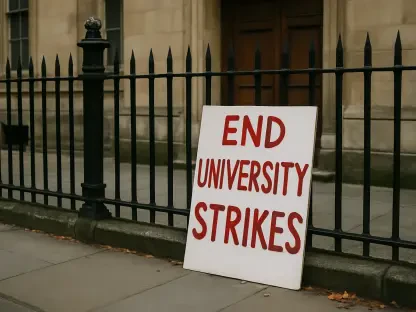Amid the national landscape of declining enrollments and fiscal uncertainties troubling many small liberal arts colleges, Albright College in Reading, Pennsylvania, is confronting a critical moment in its financial history. As colleges across the country grapple with a demographic slide that threatens their primary revenue streams, Albright has been implementing strategic measures to ensure its survival. These measures have temporarily alleviated some pressures, but underlying issues remain, calling for comprehensive long-term solutions.
Financial Struggles and Strategic Responses
Operational Deficit and Short-term Surplus
In recent fiscal years, Albright College reported an operational surplus exceeding $10 million, a notable achievement derived primarily from drastic cost-reducing actions, including significant staffing reductions. By cutting its full-time workforce in half and liquidating unneeded properties and other non-essential assets, the institution managed to forestall immediate financial peril. Nonetheless, industry experts cast doubt on the longevity of these surpluses. The largely temporary nature of these initiatives poses a risk of future deficits, especially since these numbers haven’t been through rigorous auditing. The stark reality remains that while these efforts granted a short-term reprieve, they do not substitute for a sustainable fiscal recovery strategy that the college urgently requires.
Demographic Shifts Impacting Enrollment
The broader issue afflicting Albright and similar institutions is the demographic shift known as the “demographic cliff,” which represents a dwindling of the college-aged population. The effects of decreased birth rates years ago are now manifesting as declining enrollments, putting additional financial strain on colleges that depend heavily on tuition fees. For Albright, whose income is significantly reliant on this source, maintaining and expanding student enrollment is paramount. The challenge presents the institution with an opportunity to reconsider and innovate in its academic and recruitment strategies to appeal to a broader audience and address these demographic factors head-on.
Institutional Measures and Academic Revamp
Administrative and Structural Overhauls
In response to intensified fiscal challenges, Albright College embarked on organizational changes, with the Board of Trustees taking decisive actions following a vote of no confidence in former President Jacquelyn Fetrow in 2024. The restructuring included appointing new administrators and eliminating 53 positions, reflecting an urgent need to streamline operations and resources. Academic programs perceived as less aligned with current market demands, such as economics and philosophy, were phased out in favor of introducing more sought-after fields. By doing so, the college hopes to realign its offerings with areas expected to see higher interest and employment growth, thus enhancing its appeal to prospective students and fortifying enrollment figures.
Expansion into Athletics and New Academic Programs
In an effort to bolster student enrollment and build its brand identity, Albright College is enhancing its athletic programs while introducing new course tracks. The college plans to expand its offerings with disciplines like cybersecurity and create fresh business-oriented paths, tapping into sectors with growing demand. Meanwhile, athletics remains central to Albright’s campus life, prompting initiatives to add new sports teams such as men’s and women’s wrestling and an NCAA Division III stunt program. These additions aim to enrich the student experience and draw in applicants interested in sports-related opportunities. The recent larger-than-expected incoming class suggests that these moves are beginning to yield positive results, providing hope for continued growth in student numbers.
Revenue Generation and Community Engagement
Fundraising and Financial Planning
As part of its financial revitalization effort, Albright College has placed a strong emphasis on fundraising and prudent financial management. The introduction of interim leader Debra Townsley focused on curbing costs and gearing up for increased enrollment and outreach efforts. Her administration successfully generated approximately $13.8 million from real estate sales and garnered additional unrestricted donations amounting to nearly $4 million. However, recognizing the limits of these one-time revenues, the administration is contemplating increased tuition and accommodation fees for upcoming academic years as part of a broader strategy to ensure financial health. This approach underscores the necessity of structured and continuous revenue streams rather than reliance on immediate, yet impermanent, financial solutions.
Engaging Stakeholders in a Collaborative Vision
For Albright College to achieve a sustainable turnaround, active engagement with alumni, faculty, and the surrounding community is crucial. While administrative actions have been bold and forward-looking, ensuring buy-in from all parties is paramount. Despite queries to faculty, alumni, and trustees thus far yielding limited feedback, their involvement remains a critical factor in the college’s strategic direction and future success. Strengthening these ties could potentially open doors to new collaborative ventures, enhance fundraising efforts, and create a united front dedicated to institutional recovery. As Albright seeks to carve out a viable path forward, cultivating a sense of collective ownership and commitment among its diverse constituents could prove pivotal.
Looking Ahead
Amidst a national trend of dwindling student enrollments and fiscal instability, numerous small liberal arts colleges, including Albright College in Reading, Pennsylvania, face a pivotal period in their financial journey. With demographic shifts endangering crucial revenue streams, institutions nationwide grapple for effective solutions. At Albright, proactive strategies have been set in motion, aiming to secure its future and mitigate immediate pressures. These efforts, while offering temporary relief, highlight deep-seated challenges that demand thoughtful, enduring strategies. The college’s predicament is not isolated, as similar concerns resonate broadly among other small academic institutions. Thus, the need for innovative approaches to stabilize finances and attract students is urgent. Albright’s experience might serve as a roadmap or cautionary tale for others in similar straits, emphasizing the importance of a responsive and strategic plan that addresses both immediate needs and prospective challenges.









